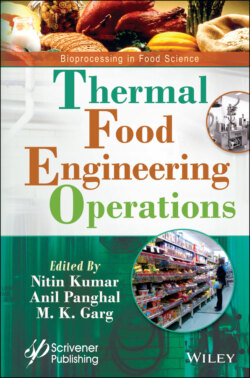Читать книгу Thermal Food Engineering Operations - NITIN KUMAR - Страница 12
1
Novel Thermal Technologies: Trends and Prospects
ОглавлениеAmrita Preetam1*, Vipasha1, Sushree Titikshya1, Vivek Kumar1, K.K. Pant2 and S. N. Naik1
1Centre for Rural Development and Technology, IIT Delhi, Delhi, India
2Department of Chemical Engineering, IIT Delhi, Delhi, India
Abstract
Heating is possibly the most traditional way of processing foods. The technologies involved in heating have been continuously developing for the past many years as per consumer need, satisfaction and demand. Techniques such as dielectric heating, ohmic heating, and infrared heating are evolving and can substitute for the conventional heating methods for improving quality and shelf life, and providing a faster production rate. The conventional technologies are primarily based on convective, conductive, and radiative heat transfer. But the new novel thermal methods are mainly relying on the electromagnetic field or electrical conductivity and are having cleaner environmental impacts such as energy saving, water savings, improved efficiencies, fewer emissions, and eventually decreasing dependency on non-renewable resources. The chapter discusses novel thermal technologies. Definitions, basic principles, environmental impacts, current trends, and future perspectives are described along with the mechanism and advantages of the novel thermal technologies. The novel thermal technologies are continuously emerging and evolving as per consumer requirements and need.
Keywords: Novel thermal technologies, infrared heating, ohmic heating, microwave heating, radiofrequency heating
